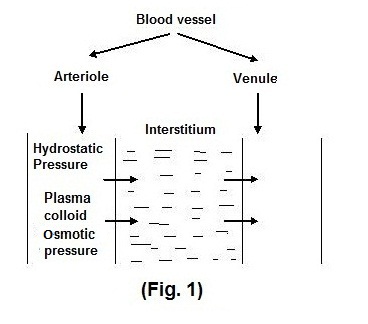Hemodynamics and Pathophysiology
All tissues and organs in the body need blood supply to have necessary biomolecules to maintain their structural and functional integrity. Nerve supply is equally important for control and coordination of their activity. We shall first consider pathophysiological aspects of blood supply.
The heart, blood vessels and the blood itself are the three components of blood supply. Majority of disease of heart and blood vessels result from derangement in metabolism, e.g. Hypertension, Atherosclerosis, etc. ultimately leading to degenerative changes. Here we will consider the result of blood flow changes as well as hemostasis changes.
Oedema
Roughly 2/3 of body water is intracellular and the rest water is extracellular especially in interstitial tissue lying in between cells. Movement of water between intravascular space and outside interstitium depends on:
- Hydrostatic Pressure i.e. pressure of liquid, in this case blood.
- Plasma colloid osmotic pressure i.e. movement of liquid due to higher concentration of solute on other side).

Normally the flow is smooth from arteriolar end to venules with very small amount in interstitium, which is drained via. lymphatics to thoracic duct and then to blood. Abnormal increase in interstitial fluid is called oedema. Anasaraca is generalized oedema with subcutaneous tissue swelling.
Oedema can result due to increase hydrostatic pressure or reduced plasma protein or retention of sodium, generally with combination of any of those functions e.g. in congestive cardiac failure poor venous return as well as decrease renal blood flow with resulting activation of rennin – angiotensin system leads to retention of sodium and water. This in turn increases blood volume leading to protein poor (deficient) collection of fluid called as transudate. In liver cirrhosis or venous obstruction in lower extremities similar phenomenon occurs.
As against this in inflammation due to increased vascular permeability the fluid which is collected is protein rich and is called exudate.
Hemodynamic changes, oedema and homoeopathic totality
If we analyse the phenomena it will be seen that metabolic alterations are the cause of oedema. But the degenerative changes are also there. Therefore it is useful to consider the drug which affect metabolism and have degenerative changes. The organs involved need to be considered.
Hyperemia and Congestion
Hyperemia denotes active blood flow at the site for example in inflammation. Passive collection of blood as occurs in venous obstruction is called congestion. In homeopathy both events are clubbed under the heading congestion. One can discriminate between the two by observing colour changes at the site. In hyperemia the color is red while in passive congestion it is dark red.
Hemorrhage
It is the extravasation of blood into the extravascular space. Besides bleeding disorder, we find in few individuals excess bleeding tendency with slight injury, inflammation etc. The drugs coming under the rubric hemorrhage need to be differentiated by referring to materia medica.
Haemostatis and thrombosis
Vascular injury may result in to hemorrhage. However, due to haemostatic mechanism, a clot is formed preventing further leakage. Vascular wall, particularly endothelium platelets and no. of other coagulation factors are responsible for clot formation.
Blood clot formation in intact vessels is called thrombus, which is pathological. It can occur due to combination of any of the following factors.
- Endothelial injury — e.g. Atherosclerotic wall, vasculitis. It causes favorable molecular alterations at the site for thrombus formation.
- Alteration in normal blood flow — e.g. slow blood flow due to any cause for example varicose veins.
- Hypercoagubality due to disturbances at molecular level participating in coagulation.
Embolus
It is the detached intravascular solid, liquid on gaseous mass which is carried to a site distant from its origin. Most common cause is thrombus.
Infarction
Occulsion either of artery or vein leads to damage to the tissue supplied by it, ultimately leading to death of tissue called necrosis. Almost all infarcts result from thrombotic or embolic occulsion.
Haemodynamics and Homeopathic Totality
Close look at haemodynamics and the pathology resulting there from reveal that number of processes underlie the phenomena. Take the example of thrombosis atherosclerosis most often accompanies it. Thus, it involves metabolism like hyperlipedemia, and chronic inflammatory reaction at endothelium. The result of thrombus may be degeneration / death of the tissue, if the obstruction encroaches upon the functioning of the tissue. Oedema, although predominating metabolic, may be associated with degenerative processes like cirrhosis. The lesson is one need to analyze the phenomena in totality which may have number of pathophysiological associates.
